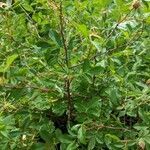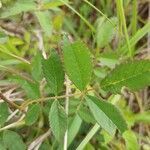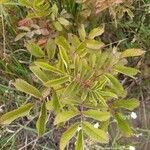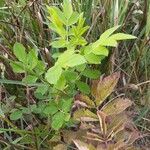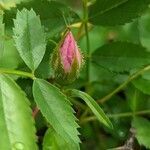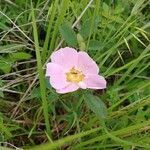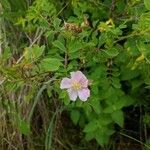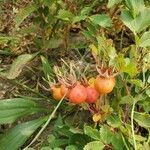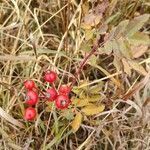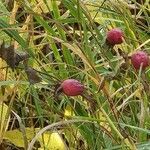Shrubs, forming hedge clusters. Stems erect, slender or stout, 6–15 dm, openly branched; bark dull red to purplish red, glabrous; infrastipular prickles rarely present, internodal prickles densely mixed with aciculi ?to stem apices?, erect, terete, 1–3(–4) × 0.5–2 mm, base rarely extending to 3 mm, smallest often gland-tipped, aciculi rarely absent. Leaves 5–10(–16) cm; stipules 18–24 × 4–7 mm, auricles flared, 2.5–4(–7) mm, margins undulate, coarsely or shallowly glandular-serrate, surfaces glabrous or puberulent, eglandular; petiole and rachis sometimes with pricklets, sometimes with sparse aciculi, pubescent, sometimes glabrous, rarely stipitate-glandular; leaflets (5–)7–9(–11), terminal: petiolule 4–12 mm, blade obovate, sometimes elliptic, 15–40 × 8–20 mm, membranous, margins 1(–2+)-serrate, teeth 8–16 per side, eglandular, rarely gland-tipped, apex acute, abaxial surfaces pale green, pubescent, sometimes glabrous, eglandular, adaxial green, ± glaucous, dull, sometimes pubescent (especially along midveins). Inflorescences corymbs, 1–6(–16)-flowered. Pedicels erect, slender, 10–20 mm, glabrous, eglandular; bracts 1 or 2(or 3), broadly lanceolate, 11–20 × 5–8 mm, margins entire, eglandular, surfaces glabrous, eglandular. Flowers 3.3–4 cm diam.; hypanthium globose, 5–6.5 × 4–5.5 mm, glabrous, eglandular, neck (0–)0.5–1.5 × 2 mm; sepals spreading to erect, lanceolate, 11–20(–30) × (1.5–)3–4 mm, tip 3–7 × 0.5–1 mm, margins pinnatifid or entire, abaxial surfaces glabrous, stipitate-glandular or eglandular; petals single, rarely double, pink or rose, sometimes fading white, rarely white, 22–26 × 21–30 mm; ?stamens 120?; carpels 26–43, styles exsert 1.5–2 mm beyond stylar orifice (1.5 mm diam.) of hypanthial disc (3 mm diam.). Hips dull orange-red, globose, subglobose, or oblong, 10–11 × 7.5–13 mm, fleshy, glabrous, eglandular, rarely stipitate-glandular, neck 0–2 mm; sepals persistent, erect at hip maturity. Achenes basiparietal, 12–15, dark buff, ?ellipsoid?, 4.5–5 × 2.5 mm. 2n = 28.
More
Colonial, only half-shrubby; stems under 1 m, usually densely prickly; prickles slender, straight, unequal, the infrastipular and internodal ones essentially alike; stipules pubescent, usually entire, or glandular-dentate toward the tip; lfls (7)9 or 11, 1–4 cm, firm, obovate or obovate-oblong, sharply serrate, very often pubescent beneath; fls corymbose, terminating the nearly herbaceous stems of the season and often also on short lateral branches from older stems; hypanthium and pedicel usually glabrous or nearly so; sep persistent, often becoming erect and connivent; pet pink (white) to deep rose, 1.5–3 cm; hips purplish or red, 10–15 mm thick; 2n=28. Prairies and plains, or in open or brushy sites eastward; N.Y. to Alta., s. to D.C., Ind., Mo., Tex., and Colo. (R. conjuncta; R. pratincola; R. suffulta)
A small suckering shrub. The branches are erect. It has many bristles. The leaves are shiny green. The flowers occur singly and are pink to red. The fruit are small round red hips.
Can be grown by cuttings or seedlings. Seeds needs scarification.
